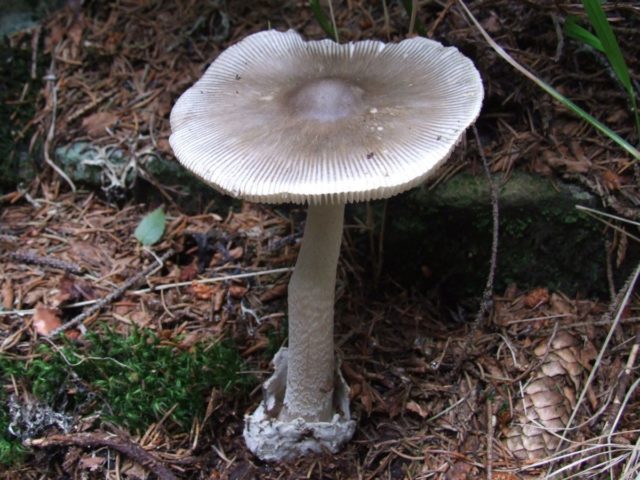Content
The mucoushead mushroom volvariella (beautiful, beautiful) is conditionally edible. He is the largest of the genus Volvariella, it can be confused with a poisonous fly agaric. Therefore, it is useful for mushroom pickers to know what this representative looks like, and where it grows. The official name is Volvariella gloiocephala.
What does volvariella mucous head look like?
Volvariella mucous head at a young age has an egg-shaped cap, enclosed in a volva. As it grows, it takes the shape of a bell, and then becomes convex-outstretched with a tubercle in the center. In dry weather, the cap is smooth and silky, it has a diameter of 5 to 15 cm. During rain, the surface becomes sticky and slimy, which is why the fruit got its name. The color of the cap is uneven - in the middle it is darker, and at the edges it has a light grayish tint.
The long and thin stem gives the mushroom a graceful look. Its maximum length can reach 20-22 cm, and its thickness is 2.5 cm. The leg has the shape of a cylinder, slightly thickened at the bottom. Its surface is smooth in adult fungi, and slightly tomentose in young ones, it is painted in white or yellowish-gray color.
Wide and frequent plates do not grow together with the stem. In young specimens, they are painted white, and in mature specimens they begin to turn pink, and then acquire a brownish-pinkish tint. The spores of the mucous-headed volvariella are light pink in color. There is no ring on the leg, the flesh at the break is white and friable, does not change color. The taste and smell are weak.
Where does volvariella mucous head grow?
Grows singly or in small groups on humus-rich soils. Can also be found in vegetable gardens, near dung and compost heaps or haystacks. The fruiting season begins in July and ends in September.
These mushrooms are also grown in artificial conditions. Volvariella mucus-headed thermophilic, therefore, in temperate climates, they grow better in greenhouses or heated rooms. Collected compost or fermented straw is used as a nutrient substrate for them. The substrate temperature should not be higher than +35 ° C, and the air temperature should not be lower than +20 ° C, the humidity in the room should not be less than 85%. Under favorable conditions, the mycelium gives its first fruits in two weeks.
Is it possible to eat mucous head volvariella
Volvariella mucous head is considered a conditionally edible mushroom, you can eat it after 15 minutes of boiling. It does not have a rich mushroom aroma and therefore does not have a high culinary value. However, it has a number of useful qualities and a mild fresh taste, thanks to which it has won the love of many gourmets.
Fresh fruits contain a large amount of vitamins and minerals necessary for maintaining health.Their low calorie content makes them an excellent dietary meal for anyone looking to lose weight. Volvariella mucous head is used in alternative medicine for the prevention of cancer and rapid recovery after chemotherapy.
False doubles
A white fly agaric looks like a volvariella mucous head. The first can be distinguished by the absence of a ring on the leg and a pink hymenophore. Amanita has a pronounced unpleasant smell of bleach and white plates.
Volvariella mucous head also resembles another conditionally edible mushroom called gray float. Unlike the latter, the mucous head volvariella has a smooth stem, a sticky surface of the cap and pink plates. All floats are edible, but mushroom pickers rarely collect them, fearing to be confused with a poisonous fly agaric.
Collection rules and use
Volvariella mucous head is harvested from July to September in places of growth - on fertile soils, near compost heaps. In order not to disturb the mycelium, the fruits are twisted out of the soil by hand, and not cut with a knife.
After collection, it is not recommended to store the mucous head volvarella, like other lamellar mushrooms. It must be rinsed several times, cleared of soil and debris, and boiled for 15 minutes. from the moment of boiling. The boiled product can be salted hot, marinated or fried with potatoes, sour cream, chicken, etc.
Conclusion
Volvariella mucoushead grows on stubble, under fences of vegetable gardens, near compost heaps. You don't need to walk through the forest for a long time. The mushroom does not contain toxic substances and is edible after boiling, but it is easy to confuse it with a white fly agaric. Therefore, when collecting, you need to be vigilant, and it is good to consider the find before putting it in your basket.











